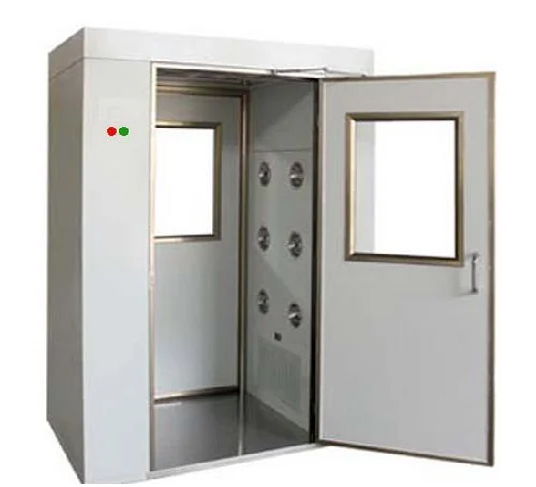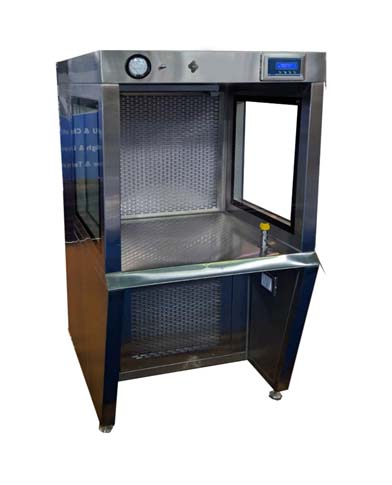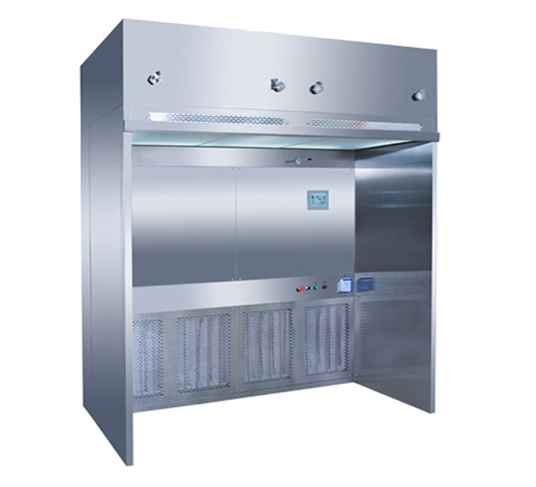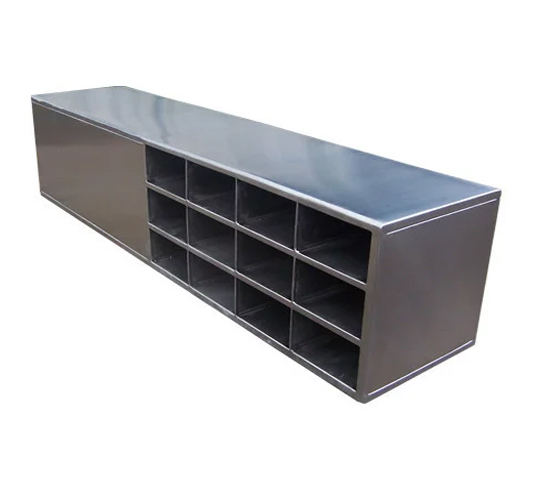
STATIC PASS BOX
A static pass box, or passive pass box, is a type of pass box that is used to transfer materials between two cleanrooms of equal cleanliness. It is designed to minimize the amount of personnel movement between the two rooms, and to prevent the cross-contamination of materials.
Static pass boxes are typically made of stainless steel, and they have two doors that are interlocked to prevent both doors from being opened at the same time. This prevents the contamination of the cleanroom environment by personnel or materials from the outside.
Static pass boxes are typically made of stainless steel, which is a durable and corrosion-resistant material that is ideal for use in cleanroom environments. The doors of a static pass box are typically interlocked to prevent both doors from being opened at the same time. This prevents the contamination of the cleanroom environment by personnel or materials from the outside.

DYNAMIC PASS BOX
A terminal housing is a small, cylindrical or rectangular piece of metal or plastic that is used to connect a wire to a circuit board or other electrical component. Terminal housings are available in a variety of sizes and shapes to accommodate different types of wires and connectors.
- Terminal housings help to prevent electrical fires by providing a safe and secure way to connect wires.
- Terminal housings help to prevent wires from becoming loose or disconnected, which can lead to electrical problems.
- Terminal housings are made of durable materials that can withstand the harsh conditions of everyday use.
- Terminal housings are available in a variety of sizes and shapes to accommodate different types of wires and connectors.
Terminal housings are typically made of a durable material, such as brass or stainless steel, to prevent corrosion and ensure a long lifespan. They are also often coated with a protective finish to further prevent damage.

AIR SHOWER
An air shower is a chamber that is used to remove particulate matter from personnel or objects before they enter a cleanroom environment. Air showers typically utilize high-pressure, HEPA- or ULPA-filtered air to remove dust, fibrous lint, and other contaminants from surfaces. The forceful "cleansing" of surfaces prior to entering clean environments reduces the number of airborne particulates introduced.
- Reduces the number of airborne particulates introduced into a cleanroom environment
- Is an essential piece of equipment for any cleanroom environment.
- Is a cost-effective way to improve the quality and safety of products.
- Is easy to clean and maintain.
Air showers are typically constructed from cleanroom-compatible steel or plastic materials and feature electronically-powered blowers, filters, and high-pressure jet nozzles, the latter being incorporated into the walls and ceiling of the chamber. Air, at velocities of 3,000 to 7,000 feet-per-minute (FPM), continuously streams from the jet nozzles for 30–45 seconds, effectively removing loose particulate matter.

LAF
A LAF unit works by drawing air through a HEPA filter, which removes 99.99% of airborne particles. The filtered air is then exhausted across a work surface in a laminar flow, meaning that the air flows in a single direction. This creates a clean environment where sensitive materials can be handled without contamination.
- Creates a controlled environment with very low levels of airborne particulates
- Helps to prevent contamination of sensitive materials
- Improves the quality and reliability of products
- Reduces the risk of product recalls
- Saves money on product testing and rework
A clean room laminar airflow (LAF) unit is a device that creates a controlled environment with very low levels of airborne particulates. It is used in a variety of industries, including semiconductor manufacturing, pharmaceutical production, and medical device manufacturing.

DISPENSING BOOTH
A cleanroom dispensing booth is a type of cleanroom equipment that is used to dispense, sample, and weigh powders and chemicals in a controlled environment. It is designed to protect the operator, the product, and the surrounding environment from contamination.
- Reduces contamination: A cleanroom dispensing booth helps to reduce contamination by providing a controlled environment where powders and chemicals can be dispensed, sampled, and weighed.
- By reducing contamination, a cleanroom dispensing booth can help to improve the quality of products by preventing the introduction of impurities.
- A cleanroom dispensing booth can help to increase productivity by providing a safe and efficient environment for operators to work in.
- A cleanroom dispensing booth can help to protect operators from exposure to harmful particles and chemicals.
Cleanroom dispensing booths are typically made of stainless steel, which is a non-reactive material that is easy to clean and maintain. They are also typically equipped with a pass-through window, which allows the operator to communicate with the outside world without opening the door and compromising the integrity of the cleanroom environment.

SAMPLING BOOTH
A clean room sampling booth is a small, enclosed area that is used to sample materials in a controlled environment. The booth is typically made of stainless steel or other non-reactive materials, and it is equipped with a HEPA filter to remove particles from the air. The booth also has a work surface, a sink, and a waste container.
- Samples taken in a clean environment are less likely to be contaminated, which can lead to improved product quality.
- Clean room sampling booths help to reduce the risk of contamination of products, personnel, and the surrounding environment.
- Clean room sampling booths can help to improve efficiency by reducing the time and effort required to take samples.
- Clean room sampling booths may be equipped with additional instrumentation, such as scales, balances, and microscopes.
Clean room sampling booths are used in a variety of industries, including pharmaceutical, medical device, and food and beverage. They are used to ensure that samples are taken in a clean environment and that they are not contaminated by outside particles.

CROSSOVER BENCH
Crossover benches are typically used in the gowning area of a cleanroom. This is the area where personnel put on their cleanroom attire before entering the cleanroom itself. The crossover bench provides a surface where personnel can sit down and put on their cleanroom shoes, gloves, and other personal protective equipment (PPE). A crossover bench is a type of bench that is used in cleanrooms. It is typically made of stainless steel and has a number of features that make it ideal for use in a cleanroom environment.
- The smooth, non-porous surface of a crossover bench makes it easy to clean and disinfect. This helps to prevent the spread of contamination in the cleanroom environment.
- Crossover benches are made of high-quality materials that can withstand the rigors of use in a cleanroom environment. This means that they are less likely to be damaged or destroyed, which can save money in the long run.
- The design of a crossover bench minimizes the risk of contamination. For example, the bench has a raised lip that helps to prevent contaminants from falling onto the floor.
Crossover bench is a valuable piece of equipment for any cleanroom. It can help to improve cleanliness, increase durability, and reduce the risk of contamination.
